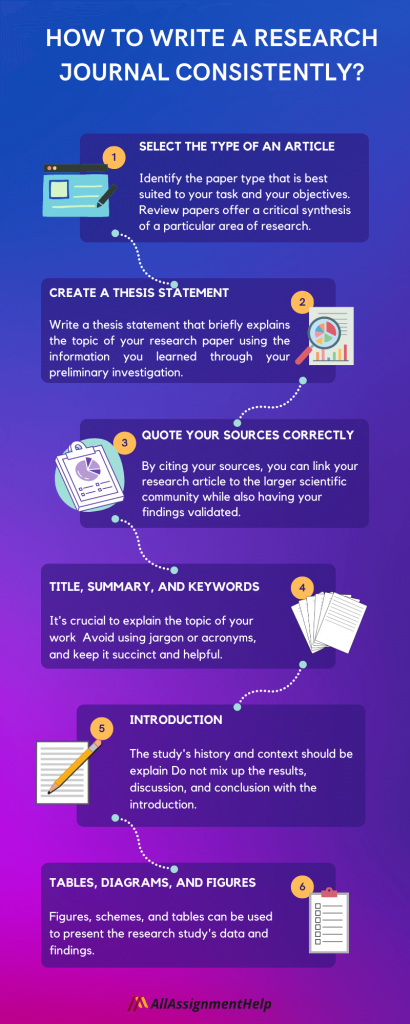A research journal is a periodical that publishes articles authored by subject-matter specialists that discuss the findings of research in their respective fields of expertise. Most universities and even school students start researching and writing journals on various topics. This research is based on various subjects like science, history, and maths. Students write research papers and it really helps them to build their careers in academic life.
Many people have told you that writing a research article is a difficult task and requires careful attention to detail. However, once you become used to it and have had enough practice during your academic career, it might be considerably simpler. However, only research and writing will not aid you unless your way of writing the research journal is proper. If you aren’t aware of how to write a research journal effectively, then this blog post of AllAssignmentHelp.com will help you know the complete process.
But, first, let us make you aware of what actually a research journal is. So, let’s get started and learn everything about writing a research article in a step-by-step manner.
What is a Research Journal?
A research journal is an organized, typically written record that is kept by a researcher for the aim of monitoring and considering occurrences pertinent to a certain research subject. Research journals offer a readily accessible source of knowledge and useful information. Readers can include scholars, researchers, and industry managers.
The significant role of a journal is to encourage the use and consideration of innovative approaches. In order to do this, the publication must offer a way to exhibit recent research findings in an approachable way.
A research journal often comes with intensive research. However, when you truly think about it, a research study only requires a few fundamental guidelines to make it easier for students who are having trouble writing it. Although students can always take research paper writing service from professionals to get a perfectly written research paper or a journal.
Read Here: How to Identify Your Research Problems?
Components of a Research Journal
The components that are found in almost every journal are the abstract, introduction, methodology, results, discussion, and references. Let’s discuss a little about them in brief below.
Abstract
The abstract is a concise summary of the key ideas in the paper (150–200 words maximum). In most cases, background information is absent. A very brief justification for doing the study could be included. It summarises what happened without going into detail. It also provides a concise summary of the findings, which typically includes the significance of the statistical tests.
Introduction
The introduction gives the background details required to comprehend why the research reported was carried out. The introduction should outline prior studies on the subject that have led to the open-ended questions being addressed by the investigation and should include citations to significant earlier works that serve as the experiment’s background information. The objectives of the study, or the exact, specific questions that will be tested in the research, should also be stated in an ordered manner in the introduction.
Methodology
This section’s purpose is to explain all experimental methods, including controls. The description must be thorough enough to allow another person to carry out your work. It is a good idea to describe your techniques and show your results in the same sequence in each component of your research if there are multiple parts to it. You must choose the presentational order that will make the most sense to your reader; it need not be the same order in which the trials were carried out.
Results
This section’s purpose is to report overall trends in the data without making any commentary, assumptions, or interpretations. Although conclusions concerning your initial hypotheses are reserved for the Discussion section, the outcomes of statistical tests performed on your data are given in this part.
Discussion
This section’s purpose is to examine the data and compare it to results from other studies. To “analyze” is to assess the relevance of your findings in relation to the initial query or hypothesis and to highlight their biological significance. Avoid repetition between the Results and the Discussion sections, though. Don’t rehash the Discussion’s extensive descriptions of the facts and outcomes.
Students who are unable to comprehend the sections of a research journal can also turn to hire an expert who can provide them research paper help online. The expert will help students to organize the complete journal in an organized and structured way.
Also Read: Types of Research Papers
If you are stuck anywhere in your writing, then don’t bear stress on your mind. Simply contact online writing services that not only help you in writing your research papers but also assist you in your assignment writing.
Proven Steps of Writing a Research Journal
Writing a research journal is not a cup of tea for students and hence we have presented here a step-by-step guide for you that can help you write a great research article journal.
Here is how you can create well-written and organized research journals

Select The Type of an Article
Identify the paper type that is best suited to your task and your objectives. Review papers offer a critical synthesis of a particular area of research. These papers typically have many more references and are significantly lengthier than the original papers. They will almost always be requested by journal editors. Reviews are a great method to establish a career in research.
Create a Thesis Statement
Write a thesis statement that briefly explains the topic of your research paper using the information you learned through your preliminary investigation. This is typically the opening paragraph of your essay, serving as the reader’s introduction to the subject.
A strong thesis statement covers all the key points of the argument without giving away too many specifics. If you’re having problems explaining anything, consider posing your subject as a question, and then responding to it. However, students can take thesis statement help online if they are having trouble creating a thesis statement for their research journal.
Quote Your Sources Correctly
Research papers differ from more informal writing like personal essays in part because of their citations. By citing your sources, you can link your research article to the larger scientific community while also having your findings validated. Citations must adhere to specific formatting guidelines because of their significance.
With all of their requirements and particular information, citations can initially seem confusing. You’ll be able to properly credit your sources without even thinking about it once you get the feel of them, though, once you do. Remember that each formatting style has distinct requirements for citing just about any type of source, such as images, websites, talks, and YouTube videos.
Title, Summary, and Keywords
It’s crucial to explain the topic of your work in the title to the reader. Similar to a newspaper headline, you want to grab their attention. Avoid using jargon or acronyms, and keep it succinct and helpful.
The title should be short and alluring enough to draw in the reader while accurately reflecting the study, identifying the primary concern, and starting with the subject. The terms “a study of,” “investigations into,” and “observations about” shouldn’t be used in titles.
Introduction
The study’s history and context should be explained in the introduction. The explanation of any prior work and the identification of knowledge gaps can each receive two or three paragraphs. The remainder of the introduction should then explain the purpose of the work and why it is significant, followed by the study’s goals and the research question. Do not mix up the results, discussion, and conclusion with the introduction.
Tables, Diagrams, and Figures
Figures, schemes, and tables can be used to present the research study’s data and findings. They ought to have degrees of statistical significance, error bars, and significant digits.
Tables should be presented with a summary title and a caption that briefly convey the contents and significance of the data they contain.
A summary title, a caption, the number of repetitions in the experiment, and a description of the significant conclusion or interpretation that may be drawn from the figure should also be included with each figure.
Review and Conclusions
The study’s key findings ought to be summarised in the discussion section. The key findings should be contrasted with prior research and knowledge at hand, and when these results have been extended, they should be extensively reported.
Your conclusion goes beyond a simple restatement of your main points. It should further the discussion from your paper and address any open issues.
Also Read: Conclusion Starters: Ending With a Bang
FAQs
| Q: What type of source is a research journal? A: Research journals or scholarly publications are considered to be secondary sources and generally report on original research or case studies. Being a secondary source, they may have pictures, graphics, or quotes of Primary data in it. |
| Q: What are the uses of research journals? A: A research journal is a convenient source of knowledge and information which can be available online. A research journal’s primary duties include publications, certification, archiving, and distribution. |
